
18g BLACKCAP,
January, and one seen in Surrey in December; and Mr. Allis says
that lie has been informed that some have been known to remain
throughout the year in Yorkshire, as, e.g., near Huddersfield aforesaid.
The males do not travel quite 1 pari passu' with the females, but
arrive some days before them. It appears however to be certain, from
the many instances already adduced, that some must stay with us
every winter, and especially it would seem in Ireland.
I t is a bird of rather shy and timid habits, and at the same time
lively and restless in its movements, quickly retiring, on being observed,
into the denser parts of its cover. It is also of a solitary nature,
more than two individuals being seldom seen in company. The cultivated
parts of the country arc its resort. It is capable of being
kept in confinement. In the 'Zoologist,' page o5(i, Vivian Wahncsley,
Esq. relates a curious circumstance of a Blackcap attacking a rabbit
which he had shot, and appearing to triumph at its death.
It seldom takes a long flight, but Hits from bush to bush.
The Blackcap feeds on insects, caterpillars, chrysalides, berries, those
of the ivy, the rowaus of the mountain ash, and others, and fruits,
such as strawberries, raspberries, blackberries, dewberries, elderberries,
cherries, pears, and currants. The first-named are sometimes captured
when flying, but chiefly found among buds,'blossoms, and leaves, and
in various parts of the trees or bushes which the bird frequents, and
in pursuit, or rather in search of them, it creeps among the dense
foliage, or threads its way through the tangled underwood with the
most graceful nimblencss and minute investigation. It occasionally
descends to the ground for the like purpose.
A very beautiful roundelay is that of the Blackcap, inferior only in
the estimation of many to that of the Nightingale. It is usually first
heard in the middle of April, but in very mild seasons has been noticed
so soon as the :J9th. of March. It will sometimes be continued until
August, if there should be a second brood. Its tones, though desultory,
are very rich, deep, full, loud, varied, sweetly wild and witching. It
is generally given forth from some of the higher branches or twigs of
the bush or hedge. The notes of other birds are also imitated—those
of the Nightingale, Blackbird, Robin, Thrush, and Garden A\ arbler.
The throat is much distended in a somewhat curious manner, and the
crest set up while the bird is singing. When the young are hatched,
' t h e song becomes broken, the melody gradually ceases, and we hear
only the usual call notes. Either are easily interrupted; and a slight
noise, or the intrusion of a stranger, will induce silence, and the bird
will remove itself gradually and quietly to the closer parts of the thicket;
or having gained the edge of a more limited shrubbery, it will silently
BLACKCAP. 188
flit to some more extensive and secure retreat.' They have also a note
of alarm like the syllable 'tack.'
The nest, built about the end of April to the end of May or ,the
beginning of June, is commonly placed in a bramble or other bush,
sometimes in a honeysuckle, a raspberry, or currant tree, about two or
three feet or rather more from the ground; sometimes among nettles.
It is made of dry grass and small fibrous roots, with occasionally a
little moss and hair—the latter as a lining, and the outer parts cemented
together with spiders' webs and wool. It is strong ami tolerably compact,
though slight. Auything like meddling with it, or intruding upon
it, is jealously watched, and the smallest disturbance causes the nest to
be forsaken. Several in fact are frequently abandoned, cither from
apprehension or caprice, before they have been finished.
The eggs, usually four or five in number, sometimes six, are of a
pale greenish or reddish white colour, mottled with light brown and
grey, with a few spots and streaks of olive, dusky, and dark brown.
They vary a good deal both in size and shape.
Frederick Stafford, Esq., of De Warren House, Northfleet, Kent,
has informed me of his having obtained from the county of Norfolk,
four eggs of this species of a beautiful salmon-colour, in no way the
effect of incubation, as only one egg had been deposited wheu the
nest was first discovered. This pink variety is not very on frequent.
J. A. Drake, Esq. has also forwarded me a g o o d variety.
Both birds sit on the eggs, but the female naturally the most. The
male frequently sings while so engaged. The female, when sitting, is
occasionally fed by her partner. The young are said to leave the
nest rather soon, roosting with their parents on the adjoining boughs.
Male; weight, about four drachms and a half; length, five inches
and three quarters to six inches and a trine over; bill, brownish
black, dark horn-colour towards the tip, paler beneath, the edges
yellowish grey, the under bill greyish blue; the inside of the mouth
bluish grey; iris, dark brown. Head on the crown, black; its sides,
the neck on the back, and nape, ash-colourcd; chin and throat, silvery
grey; breast, ash-coloured, the latter white on the lower part, tinged
with yellowish grey or brown, and pale peach blossom red on the
sides. Back, brownish ash-colour, with a tinge of green or light
yellowish grey.
The wings, which extend to nine inches and about a quarter, have
eighteen quiRs, the first feather very short and narrow, and scarcely
a third the length of the second, the second longer than the sixth,
but shorter than the fifth, the third the longest, the fourth almost
as long; greater and lesser wing coverts, greenish grey; primaries,